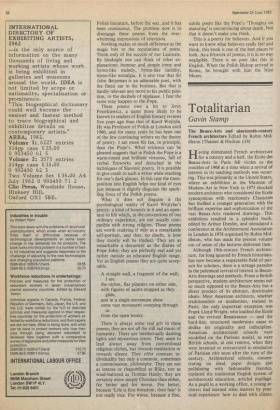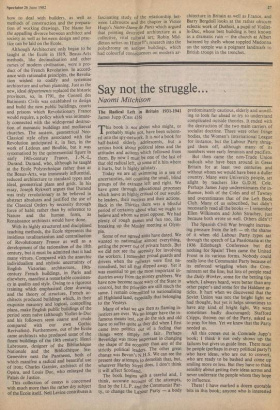Totalitarian
Gavin Stamp
The Beaux-Arts and nineteenth-century French architecture Edited by Robin Mid- dleton (Thames & Hudson £18) Having dominated French architecture for a century and a half, the Ecole des Beaux-Arts in Paris fell victim to the troubles of 1968 at a time when a revival of interest in its teaching methods was occur- ing. This was primarily in the United States, where an exhibition at the Museum of Modern Art in New York in 1975 shocked modern architects who considered the Ecole synonymous with reactionary Classicism but thrilled a younger generation with the brilliant expertise and sophistication of the vast Beaux-Arts rendered drawings. This exhibition resulted in a splendid book, edited by Arthur Drexler, and stimulated a conference at the Architectural Association in London in 1978 organised by Robin Mid- dleton, who has made the present volume out of some of the lectures delivered then.
Although 19th-century French architec- ture, for long ignored by French historians, has now become a respectable field of pur- suit for scholars, there is a strange paradox in the polemical revival of interest in Beaux- Arts drawings and methods. From a British perspective, modern architecture seems not so much opposed to the Beaux-Arts but a direct product of its abstract, doctrinaire ideals. Most American architects, whether traditionalists or modernists, trained in Paris; the only important exception was Frank Lloyd Wright, who loathed the Ecole and the revived Renaissance — and the hard-line, structured modernists came to dislike his originality and indiscipline. American architectural schools were modelled on the Parisian model, as were British schools, at one remove, when they were invented or restructured in emulation of Parisian chic soon after the turn of the century. Architectural schools, concen- trating on ideal, paper designs and pullulating with fashionable theories, replaced the traditional English system of architectural education, articled pupilage. As a pupil in a working office, a young ar- chitect had learned what matters by prac- tical experience: how to deal with clients,
how to deal with builders, as well as methods of construction and the prepara- tion of working drawings. The blame for the appalling divorce between architect and society as well as between design and prac- tice can be laid on the Ecole.
Although Architecture only began to be taught at the Ecole in 1819, Beaux-Arts methods, like decimalisation and other curses of modern civilisation, were a pro- duct of the French Revolution. In accord- ance with rationalist principles, the Revolu- tion wished to codify and systemise architecture and urban planning. Just as the new, ideal departments replaced the historic provinces, so, in 1791, the Conseil des Batiments Civils was established to design and build the new public buildings, courts and prisons which Revolutionary France would require, a policy which was intimate- ly connected with the widespread destruc- tion of monastic buildings and mediaeval churches. The austere, geometrical Neo- Classical style often associated with the Revolution anticipated it, in fact, in the work of Ledoux and Boullee, but it was systematised by the quintessential figure in early 19th-century France, J.-N.-L. Durand. Durand, who, although he taught at the Ecole Polytechnique rather than at the Beaux-Arts, was immensely influential, reduced architecture to standard types and ideal, geometrical plans and grids. In his essay, Joseph Rykwett argues that Durand was truly revolutionary as he believed in abstract absolutes and justified the use of the Classical Orders by necessity through force of habit rather than by reference to Nature and the human form, as Renaissance architects would have done.
With its highly structured and disciplined teaching methods, the Ecole represents the insidious totalitarianism and centralisation of Revolutionary France as well as a development of the rationalism of the 18th century, but it must be admitted that it had many virtues. Compared with the anarchic individualism and stylistic uncertainty of English Victorian architecture, 19th- century French buildings, in Paris and elsewhere, manifest a remarkable consisten- cy in quality and style. Owing to a rigorous training which emphasised clear drawing and the theory of structure, French ar- chitects produced buildings which, in their exquisite masonry and logical, compelling plans, make English public buildings of the period seem naive (although Viollet-le-Duc and his followers seem coarse and crude compared with our own Gothic Revivalists). Furthermore, out of the Ecole came architects who produced some of the finest buildings of the 19th century: Henri Labrouste, designer of the Bibliotheque Nationale and the Bibliotheque Ste- Genevieve next the Pantheon, both of which manifest a radical and beautiful use of iron; Charles Gamier, architect of the Opera, and Louis Duc, who enlarged the Palais de Justice.
This collection of essays is concerned with much more than the rather dry subject of the Ecole itself. Neil Levine contributes a
fascinating study of the relationship bet- ween Labrouste and the chapter in Victor Hugo's Notre-Dame de Paris which argued that printing destroyed architecture as a collective, vital cultural art; Robin Mid- dleton writes on Hittorff's research into the polychromy on antique buildings, which had colourful consequences on modern ar-
chitecture in Britain as well as France, and Barry Bergdoll looks at the rather obscure eclectic work of Duthoit, a pupil of Viollet- le-Duc, whose best building is best known as a dramatic ruin — the church at Albert battered by shells whose toppled Madonna on the steeple was a poignant landmark to British troops in the trenches.























































 Previous page
Previous page